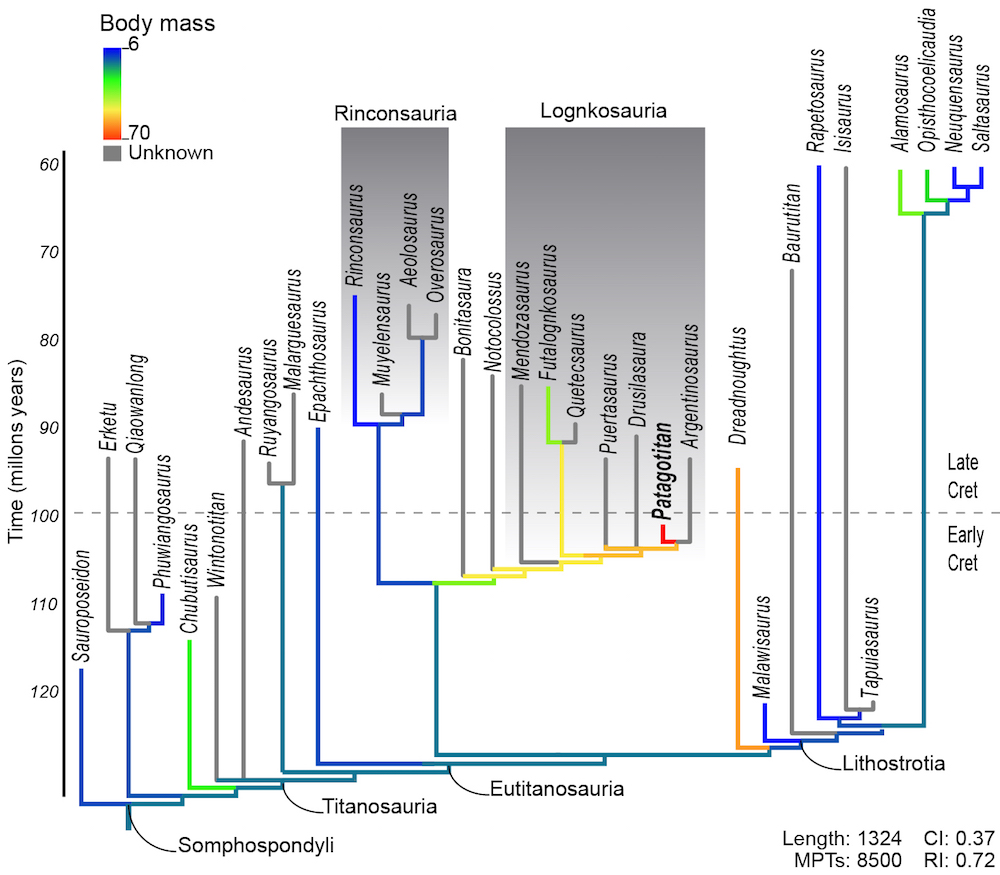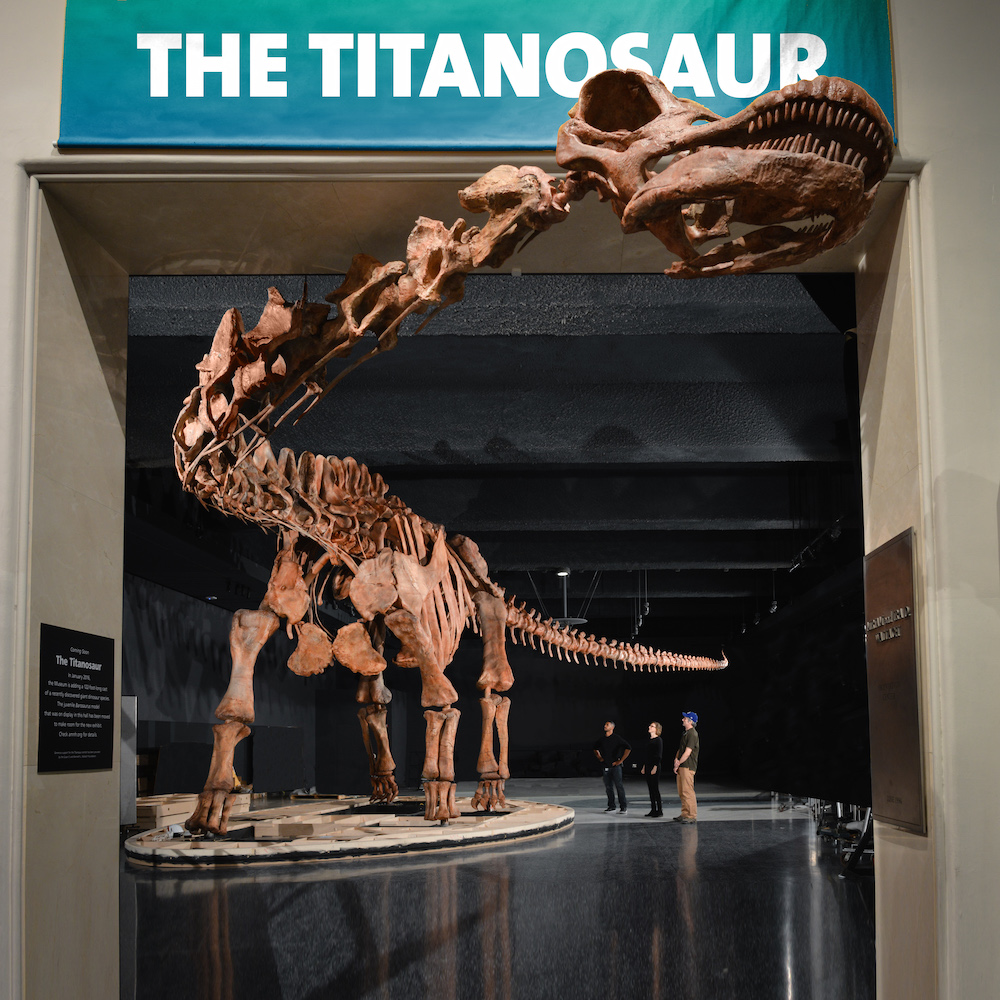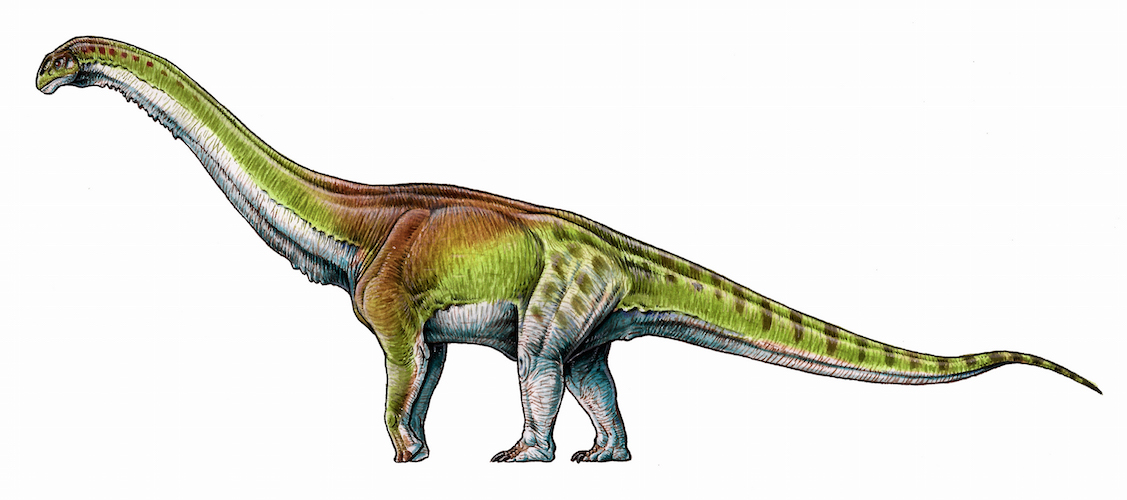Ginormous, 70-Ton Titanosaur Is the Largest Dinosaur on Record
About 100 million years ago, when flowering plants had diversified into an array of blossoms, the largest known land animal — a massive, long-necked titanosaur — stomped around, searching for plants it could eat to fuel its enormous body.
The newly identified titanosaur was so immense — 69 tons (62 metric tons), which is equivalent to the weight of nearly one dozen Asian elephants — that it has claimed the title as the largest dinosaur on record, surpassing the previous record holder, another titanosaur known as Argentinosaurus hiunculensis.
Although it's exciting to discover the world's largest land-dwelling beast, the researchers said they're even more thrilled about the vast number of fossilized bones they uncovered, belonging to at least six of the giants. By comparing these newfound bones with those of other titanosaurs, the researchers were able to construct a comprehensive titanosaur family tree, they said. [See Images of the Titanosaur, the Largest Known Dinosaur to Live on Earth]
This family tree shows that some of Patagonia's giant titanosaurs — including Argentinosaurus, Puertasaurus, Notocolossus and the newly identified dinosaur — are part of the same evolutionary group, known as a clade.
This clade indicates that "extreme gigantism evolved once in the history of sauropods" rather than multiple times, said study lead researcher José Luis Carballido, a researcher with the Argentine National Research Council (CONICET) who works at the Museum of Paleontology Egidio Feruglio in Trelew, a city in the Chubut province of Argentina.

Colossal discovery
The modern story of the mid-Cretaceous titanosaur began in 2012, when Aurelio Hernandez, a worker on La Flecha ranch in Patagonia, Argentina, found some fossils one day while managing the ranch's sheep. Hernandez showed the spot to one of the ranch's owners, Oscar Mayo, who immediately realized that the specimens were likely dinosaur remains.
Mayo invited paleontologists at the museum to see the site, and they spent a total of 18 months excavating the bones, including an 8-foot-tall (2.4 meters) femur, or thighbone. An analysis revealed that the site contained the remains of at least six different individuals, Carballido told Live Science.
Sign up for the Live Science daily newsletter now
Get the world’s most fascinating discoveries delivered straight to your inbox.
The finding was so momentous that the researchers allowed the American Museum of Natural History in New York City to display a cast of the dinosaur's skeleton in 2016, before the beast was even named. At 122 feet (37 m) long, the reconstructed dinosaur was so huge it couldn't fit into one room, and so museum curators positioned its long neck and tiny head to poke out into the museum's hallway, welcoming guests.
Now that researchers have had time to analyze the titanosaur's bones, they've formally named it Patagotitan mayorum. The genus name references Patagonia, where the dinosaur was found, and "titan" recalls Greek divinities, known for their strength and large size. The species name honors the Mayo family for their hospitality during the excavation, the researchers said in the study.
Superbig
Although all six of the P. mayorum were massive, an analysis of five femur bones and one humerus (a forelimb bone between the shoulder and elbow) revealed that these individuals "had not stopped growing," the researchers wrote in the study.
Even so, they were quite tall, and could likely reach almost 50 feet (15 m) high if their necks were pointing straight up, Carballido said. [Photos: Enormous Titanosaur Invades New York Museum]

Given that these dinosaurs were not fully grown, "this means that there are even bigger dinosaurs out there to discover," said Kristina Curry Rogers, a paleontologist at Macalester College in St. Paul, Minnesota, who was not involved with the study.
Still, it's important to note that P. mayorum isn't the largest animal by weight in the world. That honor goes to the blue whale (Balaenoptera musculus), which can weigh up to 200 tons (180 metric tons).
Vanishing lake
The six individuals were recovered from three different layers, or time periods. Perhaps so many individuals died there because there was once a lake in the region, prompting the titanosaurs to return time and again to drink from its waters, Carballido said. This is the first time that this concept, known as site fidelity, has been documented for such large animals, Carballido said.
It's possible that this lake dried out during droughts, and that these six titanosaurs died, in part, from thirst during those times, said Stephen Poropat, a paleontologist at Swinburne University of Technology in Melbourne, Australia, who was not involved in the study.
"The stench of their rotting carcasses would have attracted carnivorous theropods [such as] Tyrannotitan, who lost teeth as they fed," Poropat told Live Science in an email. As the theropods chowed down, some of the P. mayorum bones could have been "pushed deeply into the mud," ultimately fossilizing, he added. [Dinosaur Detective: Find Out What You Really Know]
"It will be interesting to see if any of the bones have tooth marks on them," Poropat said.
Humungous thighs
The P. mayorum fossils are "very impressive" because they are so well-preserved and enormous, Poropat said. For instance, "the thighbones they have discovered equal or exceed every other thighbone in the fossil record in size," he said.
"There is no doubt that it was pushing at the upper limits of body size, and it will be interesting to see what adaptations it developed to cope with all of the pressures that went with being so big, [such as] acquiring enough food [and] finding a mate," Poropat said.

Poropat noted that the largest titanosaurs lived within a fairly narrow time span during the mid-Cretaceous, between 113 million and 83 million years ago, in southern South America.
Perhaps the long necks and tails of these titanosaurs helped them lose excess heat, as this period had warmer-than-usual temperatures, Poropat said.
The study will be published online Wednesday (Aug. 9) in the journal Proceedings of the Royal Society B.
Original article on Live Science.

Laura is the archaeology and Life's Little Mysteries editor at Live Science. She also reports on general science, including paleontology. Her work has appeared in The New York Times, Scholastic, Popular Science and Spectrum, a site on autism research. She has won multiple awards from the Society of Professional Journalists and the Washington Newspaper Publishers Association for her reporting at a weekly newspaper near Seattle. Laura holds a bachelor's degree in English literature and psychology from Washington University in St. Louis and a master's degree in science writing from NYU.










